Abstract
1. Sixty-seven afferents from the finger extensor muscles were consecutively recorded by microneurography. 2. The units were classified as primary or secondary muscle spindle afferents or Golgi tendon organ afferents on the basis of their responses to ramp-and-hold stretches, sinusoidals superimposed on ramp-and-hold stretches, maximal twitch contractions and isometric contractions and relaxations. 3. The muscle was repeatedly stretched and then either kept short or long for a few seconds followed by a slow ramp stretch. The responses of the muscle afferents to the slow stretch were compared under the two conditions. 4. Thirty out of thirty-eight units classified as primary spindle afferents and four out of eleven units classified as secondary afferents showed an enhanced response to the slow ramp when the muscle had been kept short compared to the response when the muscle had been kept long. 5. None of the eighteen Golgi tendon organ afferents showed any difference in this respect. 6. It is concluded that stretch sensitization does occur in human muscle spindles and, when present, constitutes firm evidence of the afferent originating from a muscle spindle rather than a Golgi tendon organ. In addition, due to differences in the response characteristics of primaries and secondaries, the test may aid in separating muscle spindle primary afferents from secondary afferents.
Full text
PDF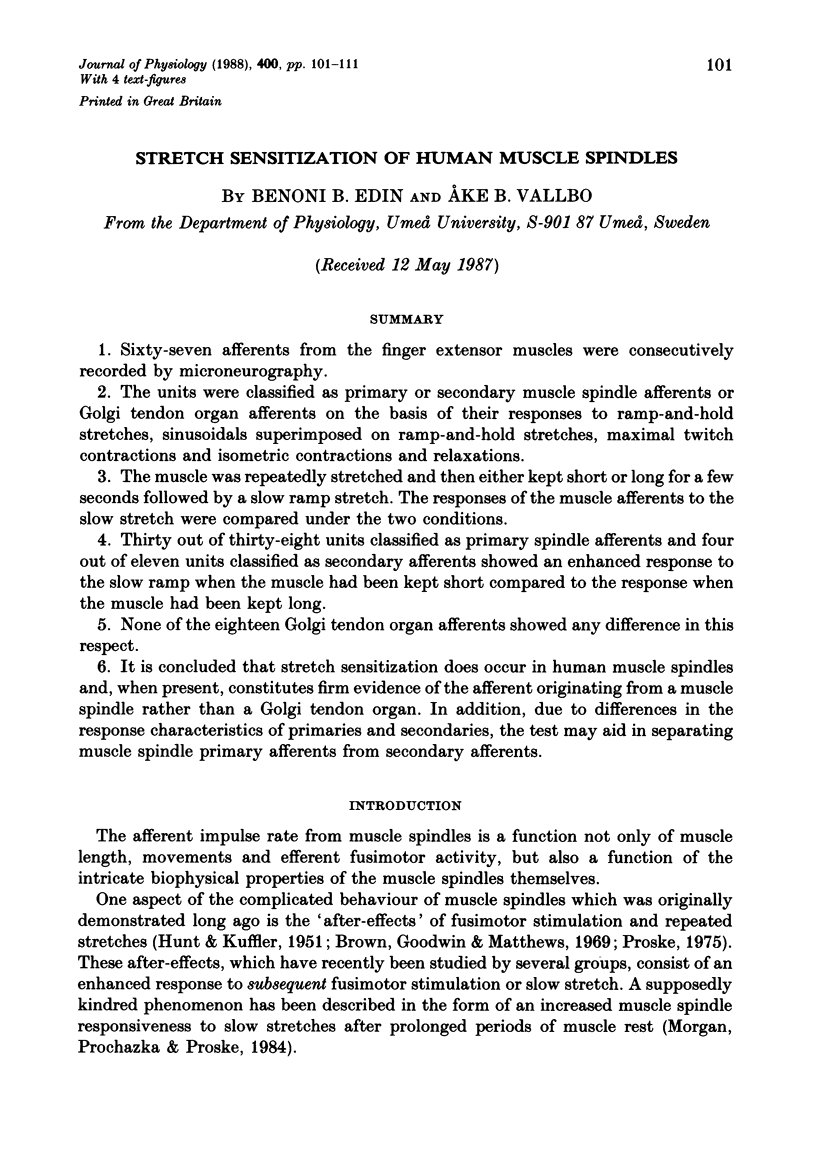
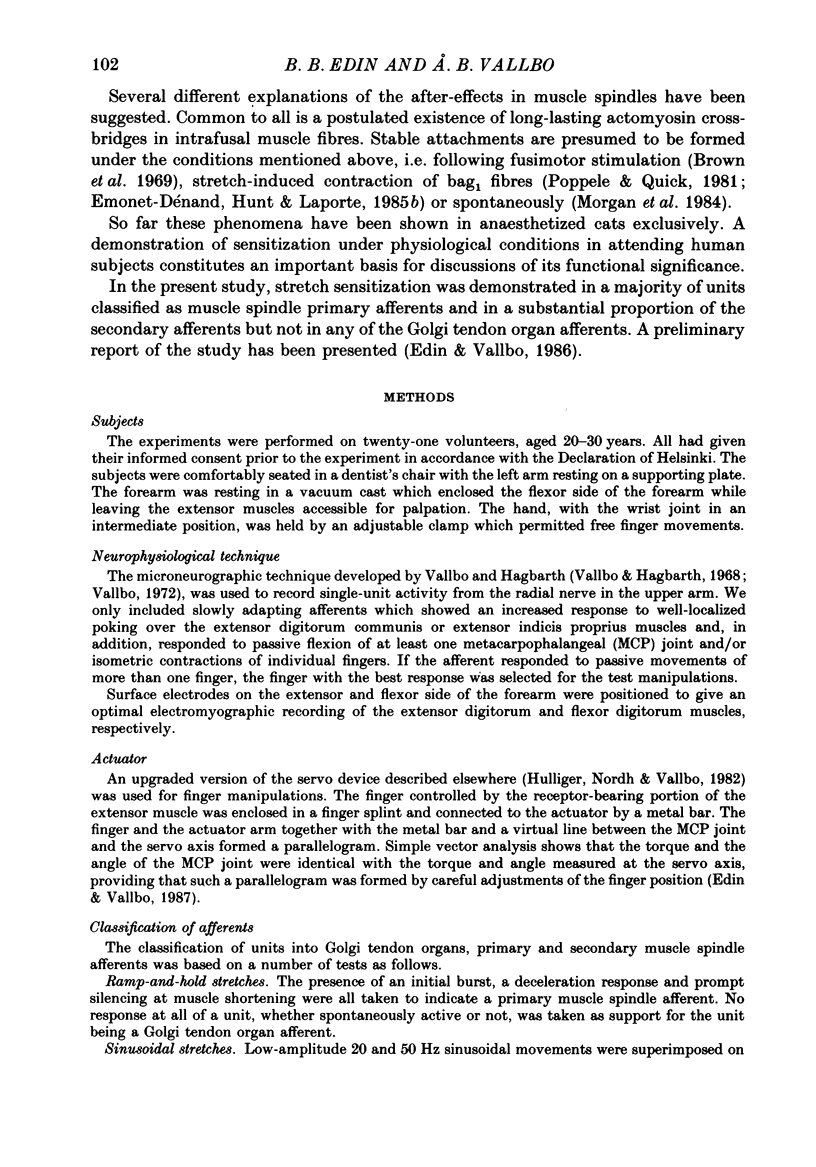

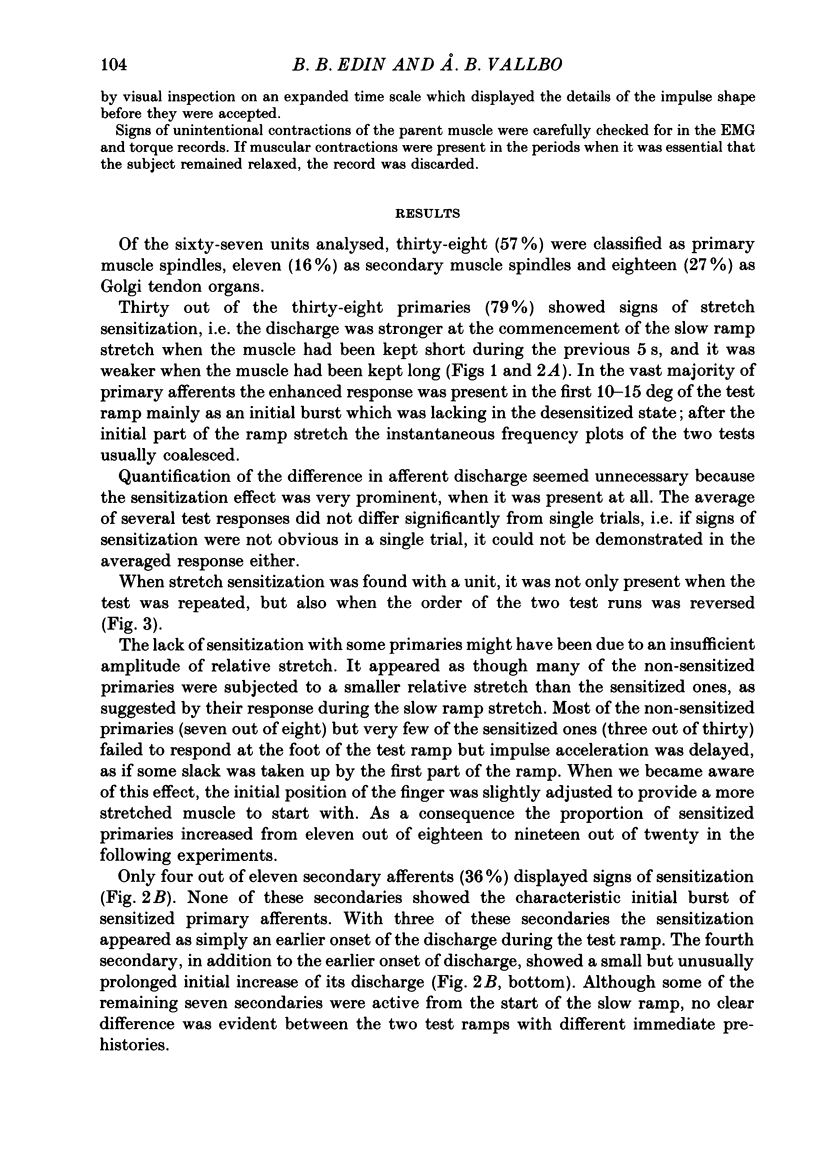

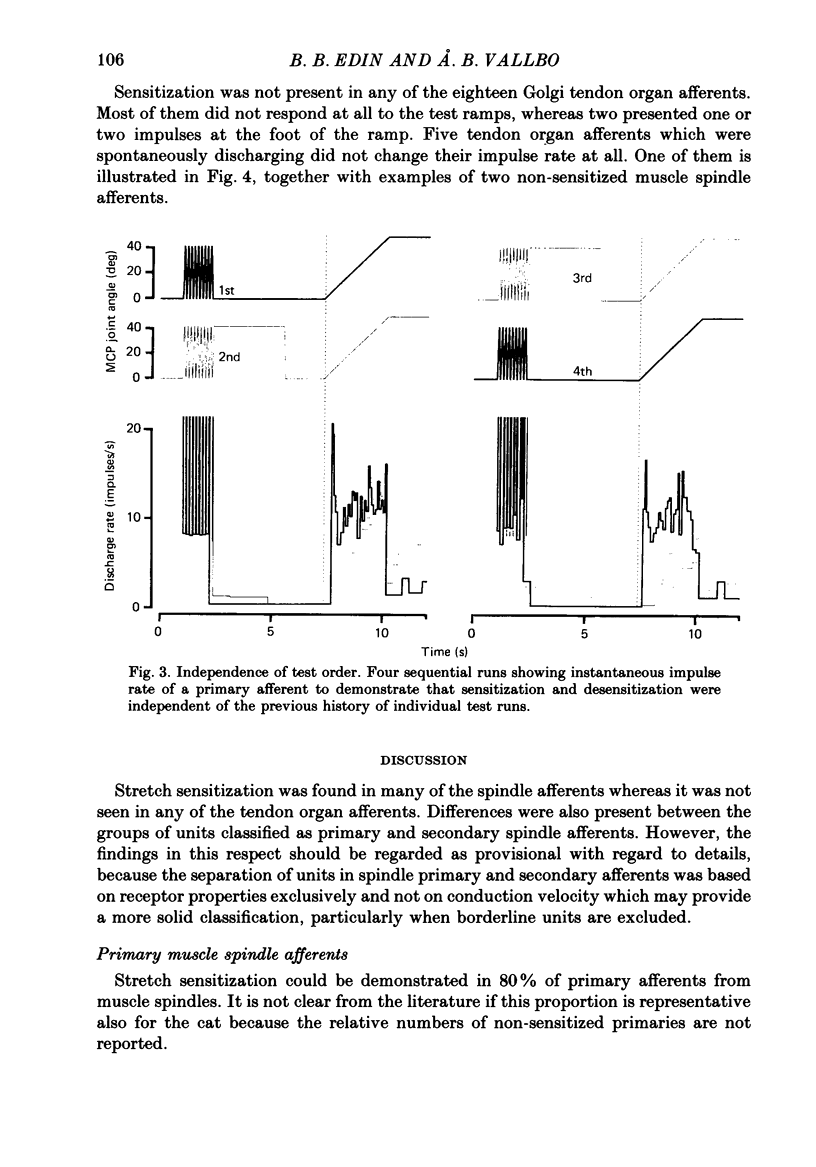
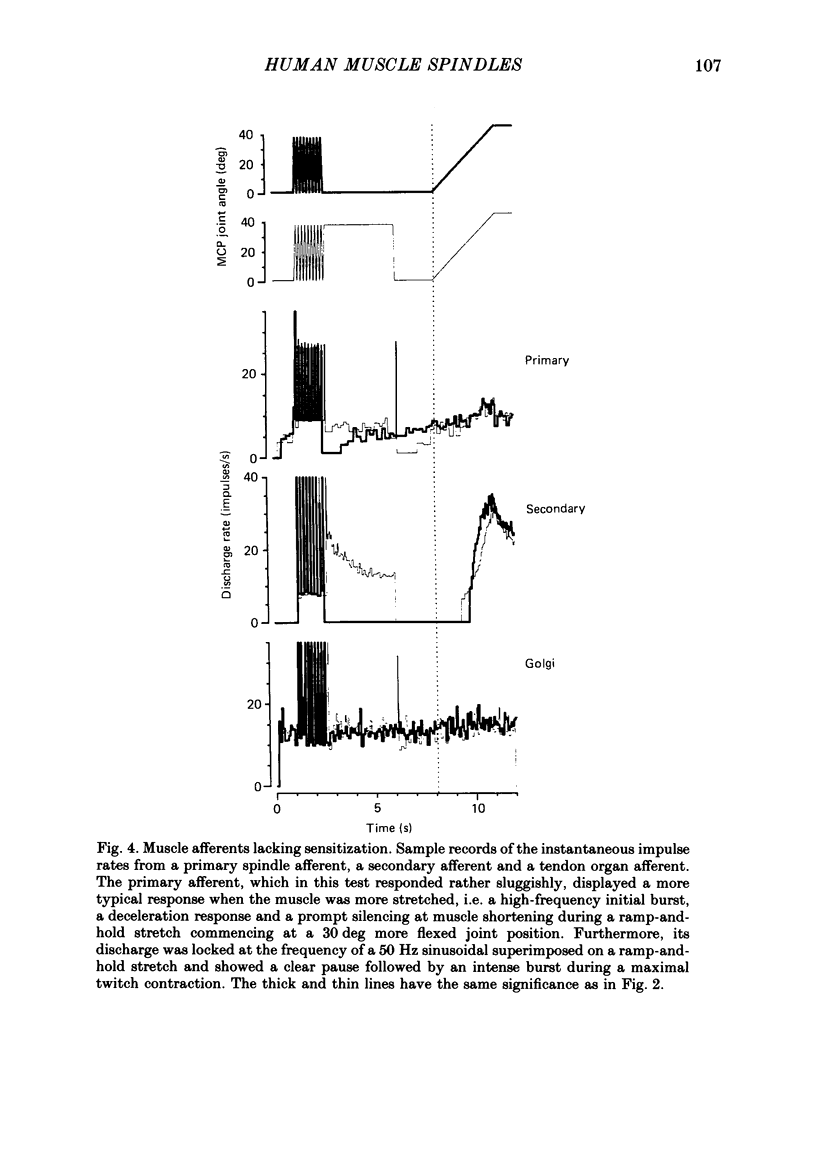



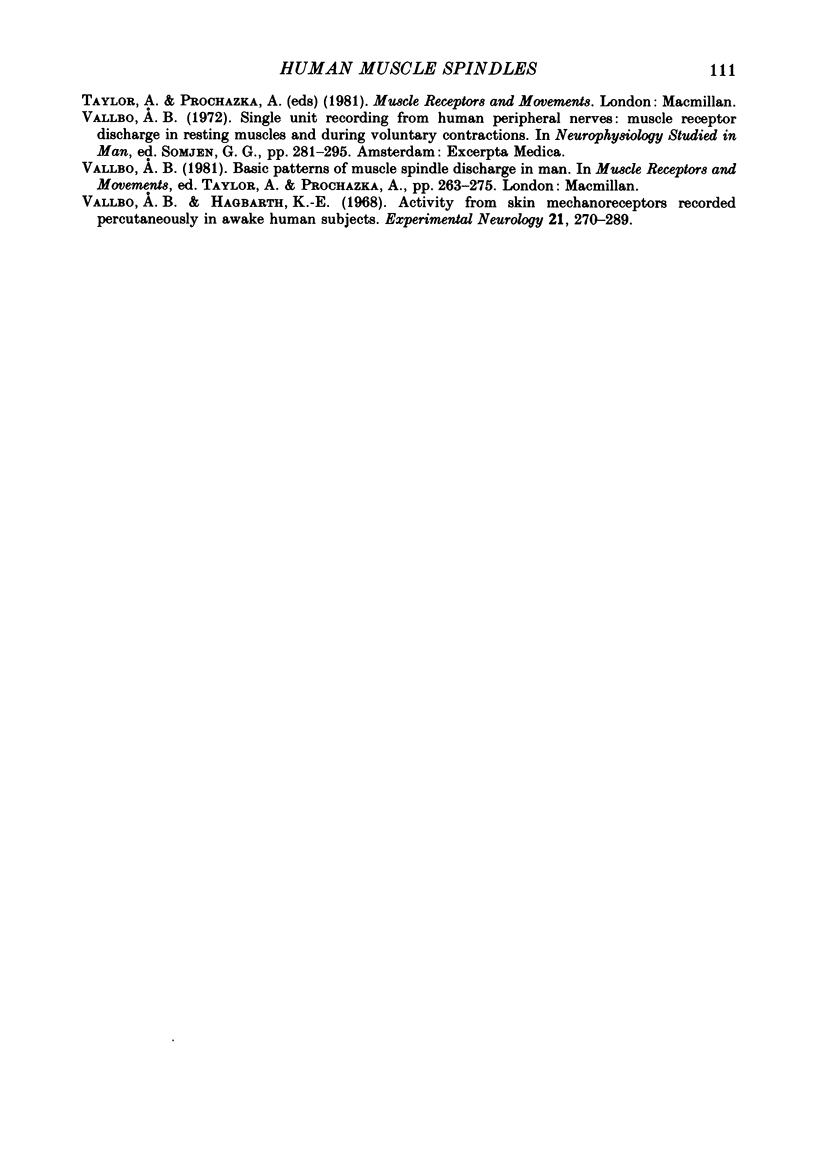
Selected References
These references are in PubMed. This may not be the complete list of references from this article.
- Brown M. C., Goodwin G. M., Matthews P. B. After-effects of fusimotor stimulation on the response of muscle spindle primary afferent endings. J Physiol. 1969 Dec;205(3):677–694. doi: 10.1113/jphysiol.1969.sp008990. [DOI] [PMC free article] [PubMed] [Google Scholar]
- Edin B. B., Vallbo A. B. Twitch contraction for identification of human muscle afferents. Acta Physiol Scand. 1987 Sep;131(1):129–138. doi: 10.1111/j.1748-1716.1987.tb08214.x. [DOI] [PubMed] [Google Scholar]
- Emonet-Dénand F., Hunt C. C., Laporte Y. Effects of stretch on dynamic fusimotor after-effects in cat muscle spindles. J Physiol. 1985 Mar;360:201–213. doi: 10.1113/jphysiol.1985.sp015612. [DOI] [PMC free article] [PubMed] [Google Scholar]
- Gregory J. E., Morgan D. L., Proske U. Aftereffects in the responses of cat muscle spindles. J Neurophysiol. 1986 Aug;56(2):451–461. doi: 10.1152/jn.1986.56.2.451. [DOI] [PubMed] [Google Scholar]
- HUNT C. C., KUFFLER S. W. Further study of efferent small-nerve fibers to mammalian muscle spindles; multiple spindle innervation and activity during contraction. J Physiol. 1951 Apr;113(2-3):283–297. doi: 10.1113/jphysiol.1951.sp004572. [DOI] [PMC free article] [PubMed] [Google Scholar]
- Hagbarth K. E., Hägglund J. V., Nordin M., Wallin E. U. Thixotropic behaviour of human finger flexor muscles with accompanying changes in spindle and reflex responses to stretch. J Physiol. 1985 Nov;368:323–342. doi: 10.1113/jphysiol.1985.sp015860. [DOI] [PMC free article] [PubMed] [Google Scholar]
- Hill D. K. Tension due to interaction between the sliding filaments in resting striated muscle. The effect of stimulation. J Physiol. 1968 Dec;199(3):637–684. doi: 10.1113/jphysiol.1968.sp008672. [DOI] [PMC free article] [PubMed] [Google Scholar]
- Hulliger M., Nordh E., Vallbo A. B. The absence of position response in spindle afferent units from human finger muscles during accurate position holding. J Physiol. 1982 Jan;322:167–179. doi: 10.1113/jphysiol.1982.sp014030. [DOI] [PMC free article] [PubMed] [Google Scholar]
- Marchand R., Bridgman C. F., Shumpert E., Eldred E. Association of tendon organs with spindles in muscles of the cat's leg. Anat Rec. 1971 Jan;169(1):23–32. doi: 10.1002/ar.1091690103. [DOI] [PubMed] [Google Scholar]
- Morgan D. L., Prochazka A., Proske U. The after-effects of stretch and fusimotor stimulation on the responses of primary endings of cat muscle spindles. J Physiol. 1984 Nov;356:465–477. doi: 10.1113/jphysiol.1984.sp015477. [DOI] [PMC free article] [PubMed] [Google Scholar]
- Poppele R. E., Quick D. C. Stretch-induced contraction of intrafusal muscle in cat muscle spindle. J Neurosci. 1981 Oct;1(10):1069–1074. doi: 10.1523/JNEUROSCI.01-10-01069.1981. [DOI] [PMC free article] [PubMed] [Google Scholar]
- Proske U., Gregory J. E. The time-course of recovery of the initial burst of primary endings of muscle spindles. Brain Res. 1977 Feb;121(2):358–361. doi: 10.1016/0006-8993(77)90159-7. [DOI] [PubMed] [Google Scholar]
- Proske U., Morgan D. L. After-effects of stretch on the responses of cat soleus muscle spindles to static fusimotor stimulation. Exp Brain Res. 1985;59(1):166–170. doi: 10.1007/BF00237676. [DOI] [PubMed] [Google Scholar]
- Proske U. Stretch-evoked potentiation of responses of muscle spindles in the cat. Brain Res. 1975 May 2;88(2):378–383. doi: 10.1016/0006-8993(75)90403-5. [DOI] [PubMed] [Google Scholar]
- Vallbo A. B., Hagbarth K. E. Activity from skin mechanoreceptors recorded percutaneously in awake human subjects. Exp Neurol. 1968 Jul;21(3):270–289. doi: 10.1016/0014-4886(68)90041-1. [DOI] [PubMed] [Google Scholar]


